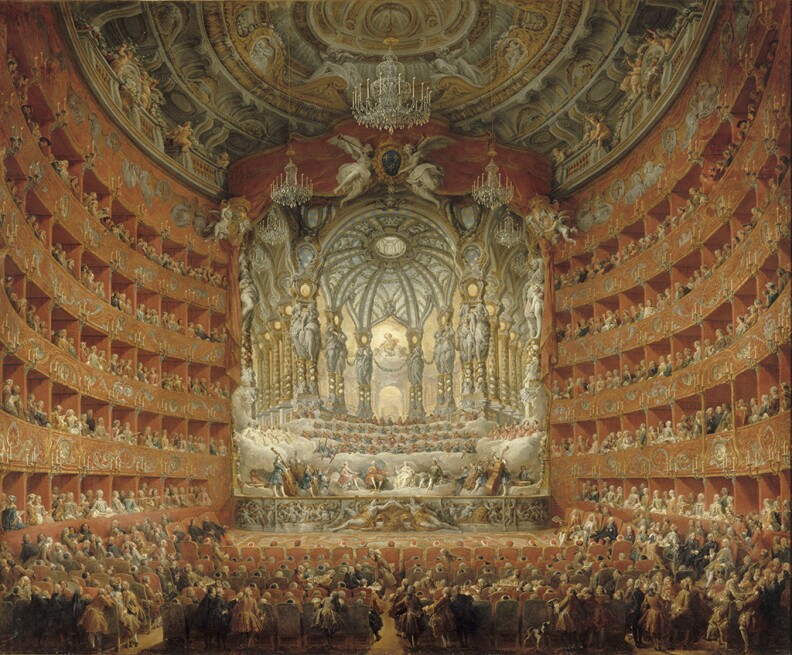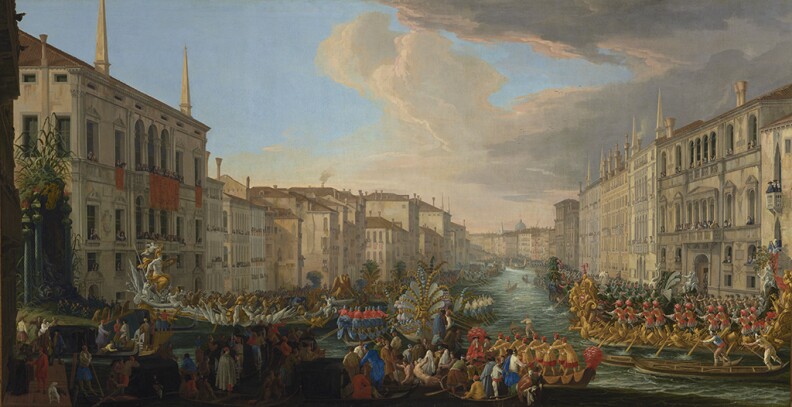Off-Ramp culture correspondent Marc Haefele reviews Eyewitness Views: Making History in Eighteenth-Century Europe, at the Getty Center through July 30.
Jaded souls in the last century used the term “pseudo event” as a criticism of any event that was staged, rather than occurring naturally. According to the Getty’s lavish new show, “Eyewitness Views,” this was not a valid distinction in 1700s Europe. Particularly in Rome and Venice, but even in cities as far flung as London, Madrid and Warsaw, the more contrived and staged the public event was, the more worthy it seemed of an immense artistic commemoration in the form of a mighty and intricate painting, usually by one of a group of specialists known as View Painters.
Some of these — Guardi and Canaletto, for instance -- are best known today for masterly renderings of canals, palaces, squares and classical ruins for rich tourists. But they, like the lesser known Panini, Calavarijs and Belloto, were also memorializing the spectacles of the Age of Enlightenment, usually in honor of occasions like royal births, weddings, the elevation of a ruler, the arrival or departure of a prince or a pope or even a mere ambassador. Any of which was likely to foment mighty, if temporary, architectural monuments, immense costume parades, regattas, or monster musical theatrical productions with performers by the hundred. Many of these they recorded for posterity, in more detail that you might suppose to be humanly possible.
![Öl auf Leinwand <br>Bernardo Michiel Bellotto (Canaletto) [1720 - 1780]<BR>Bernardo Bellotto, gen. Canaletto Venedig 1721 - 1780 Warschau . 1765<BR>Inventar-Nr.: Gal. Nr. 638](https://scpr.brightspotcdn.com/dims4/default/7ae0c93/2147483647/strip/true/crop/1024x743+0+0/resize/792x575!/quality/90/?url=https%3A%2F%2Fa.scpr.org%2F160733_7af2a80b7b2e8b13043b962d6a18c796_original.jpg)
A fine collection of these great oil-painted transcriptions, curated by Peter Bjorn Kerber, is what we have at the Getty: it is amazing to think that nobody ever before thought to do an exhibit of what amount to some of the most spectacular pictures of an entire century, granting us immensely enlarged snapshots from up to 300 years in the past.
Kerber notes that there is a certain aspect of mass-production to some of these mighty canvases. Rather than render all of hundreds of people over and over again for different paintings, an artist might keep a stockpile of sketches, so that a man in blue in one painting might show up wearing brown in another. He also noted that what appears to be a literal view of a massive occurrence could be built on illusions, just to make it possible to include all the participants. In one painting, he pointed out, “a wall had been removed and the painter’s point of view is from 10 feet off the floor.’’

Despite or because of these liberties, the sense of reality is immense. Panini’s "Musical Performance in the Teatro Argentina in Honor of the Marriage of the Dauphin of France" appears to give us all the hundred or so performers arranged in cloudy tiers across the stage, as well as an audience of over a thousand on the main floor and in five tiers of boxes and balconies. It's as though Panini was desperately afraid of leaving anyone out. So strong is the sense of being present that the average viewer can’t help feeling direly underdressed for this glitteringly costumed presentation.
MEANTIME: Check out a modern California artist whose work is just as detailed
Just as stunning are the exterior functions shown here, particularly Canaletto’s regatta festivals, whose flag-draped, gilded, red-trimmed longboats make our Rose Bowl floats look drab. Kerber stresses that it wasn’t all fun and festivities for the eye-witness masters of the 18th century. On occasion, they had to capture genuine events, genuine disasters. They acquitted themselves magnificently. Parisian Hubert Robert strikingly rendered the burning Palais-Royal opera house in 1781. Pierre Jacques-Volaire did several views of the 1771 explosion of Mt. Vesuvius. 18 years later, Hubert Robert recorded for us a destructive event that was to trigger an even greater explosion, one that would end forever that era’s aristocratic, pompous and glistering rituals so loved by the view painters. It was the destruction of the Bastille.
...
Nearby, in another Getty Gallery, there’s a simple drawing of a structure that in sheer extravagance and implausibility puts anything by Panini and his colleagues to shame. It’s by the great architectural fantasist Giovanni Piranesi, and it’s called “View of an Ancient Port.” A vaulting vision of waterfront arches, columns, pediments and pilasters rising to a barely suggested sky, it could never have existed in reality but will stay forever in your imagination.

It’s one of the highlights of the exhibit called “The Lure of Italy: Artists’ Views.” It consists largely of drawings and water colors, work on the run, so to speak, of the same general period as "Eyewitness Views." It is a beguiling display of enormous talents, limning many elegant, for the most part under-portrayed, sights in Italy, from the heart of Rome to the waterfalls of Terni. The danger of it is that it might actually inspire you to toss some drawing pads in your back pack and immediately book a cheap ticket to Rome.



